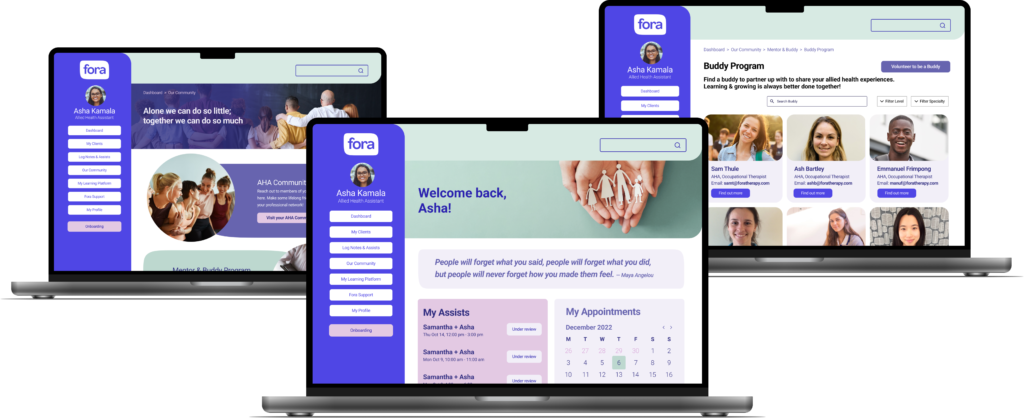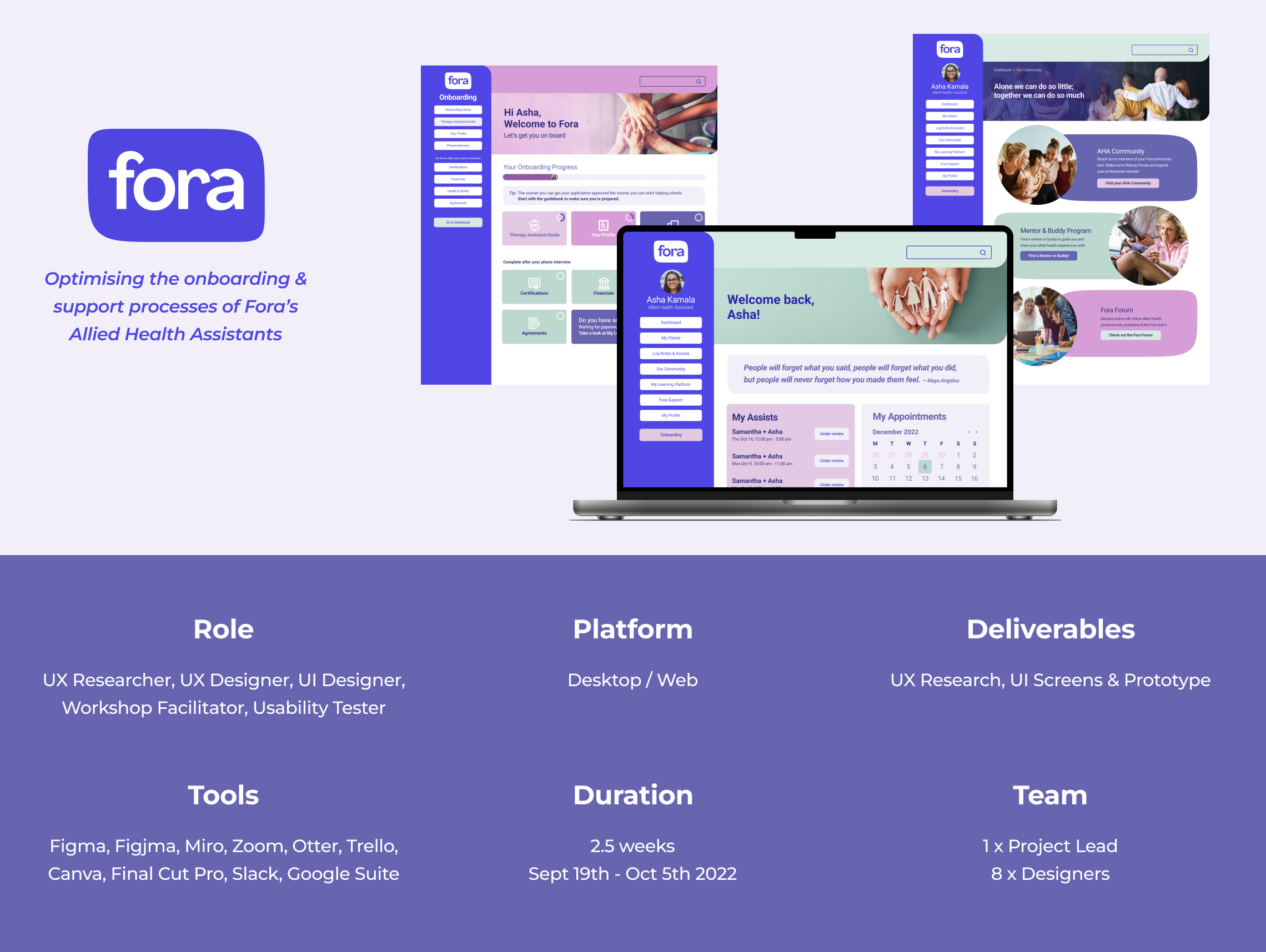
The Challenge
Fora wants to know why they are experiencing failed client matches and poor retention with their Allied Health Assistants (AHA). We were brought on to investigate the reasons behind this, and to design a solution to improve AHA confidence.
Previously named Ally Assist, Fora builds therapy teams, matching clients with the perfect Allied Health Assistant (AHA) and an Allied Health Professional (AHP) so that they can reach their therapy goals.
Fora has been experiencing an issue with AHA retention and failed client matches and they believed it was related to their onboarding processes. Along with a team of designers, we discovered that the onboarding process wasn’t the problem, rather, AHAs want more ongoing support and development.
Our Design Process
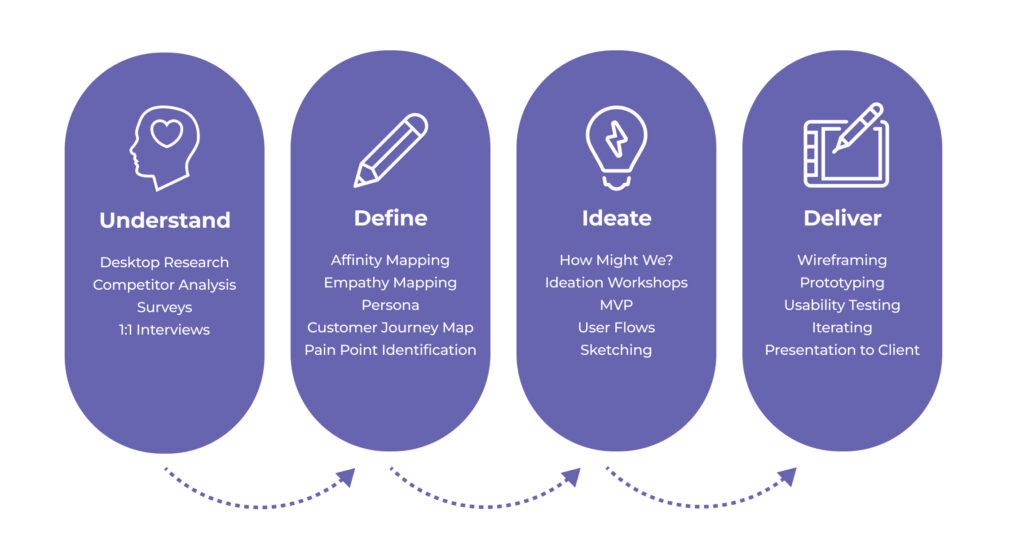
My Roles & Responsibilities
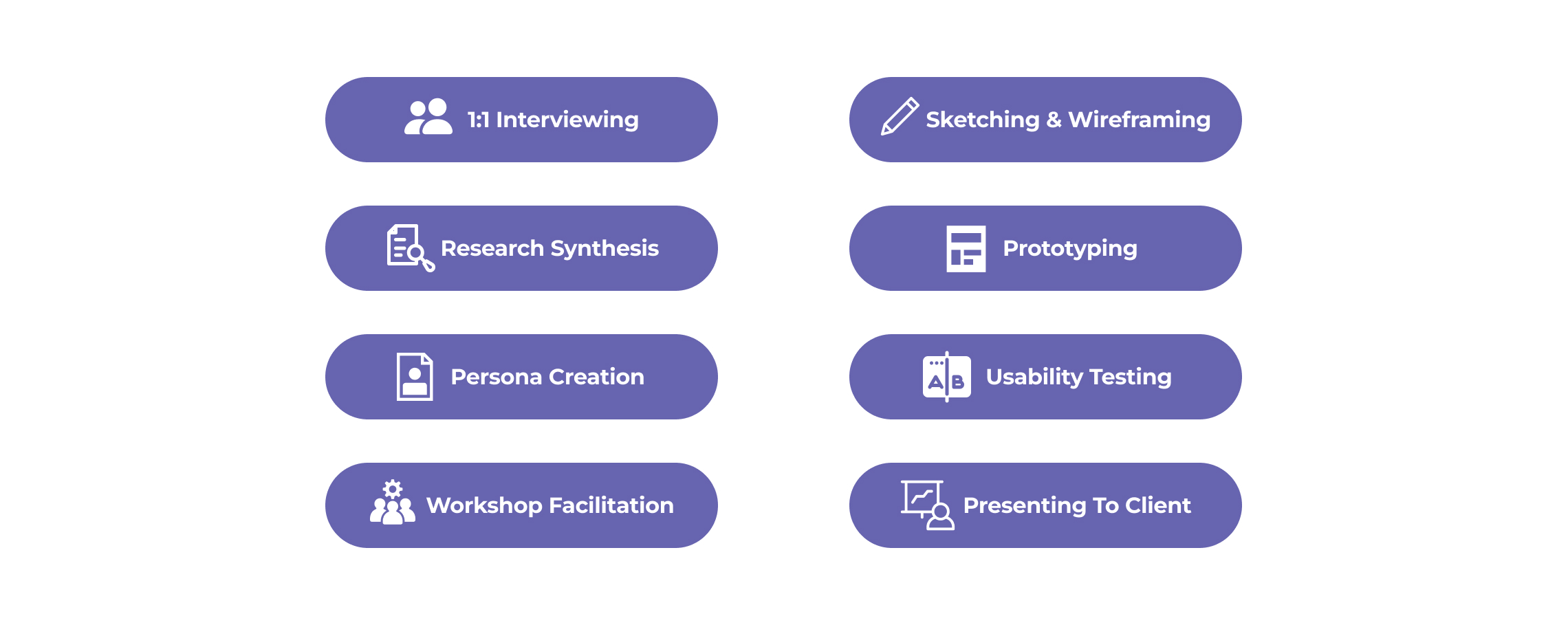
The Solution
Based on research insights, we redesigned and tested Fora’s online portal, streamlining their onboarding processes and implementing programs to support their AHAs.
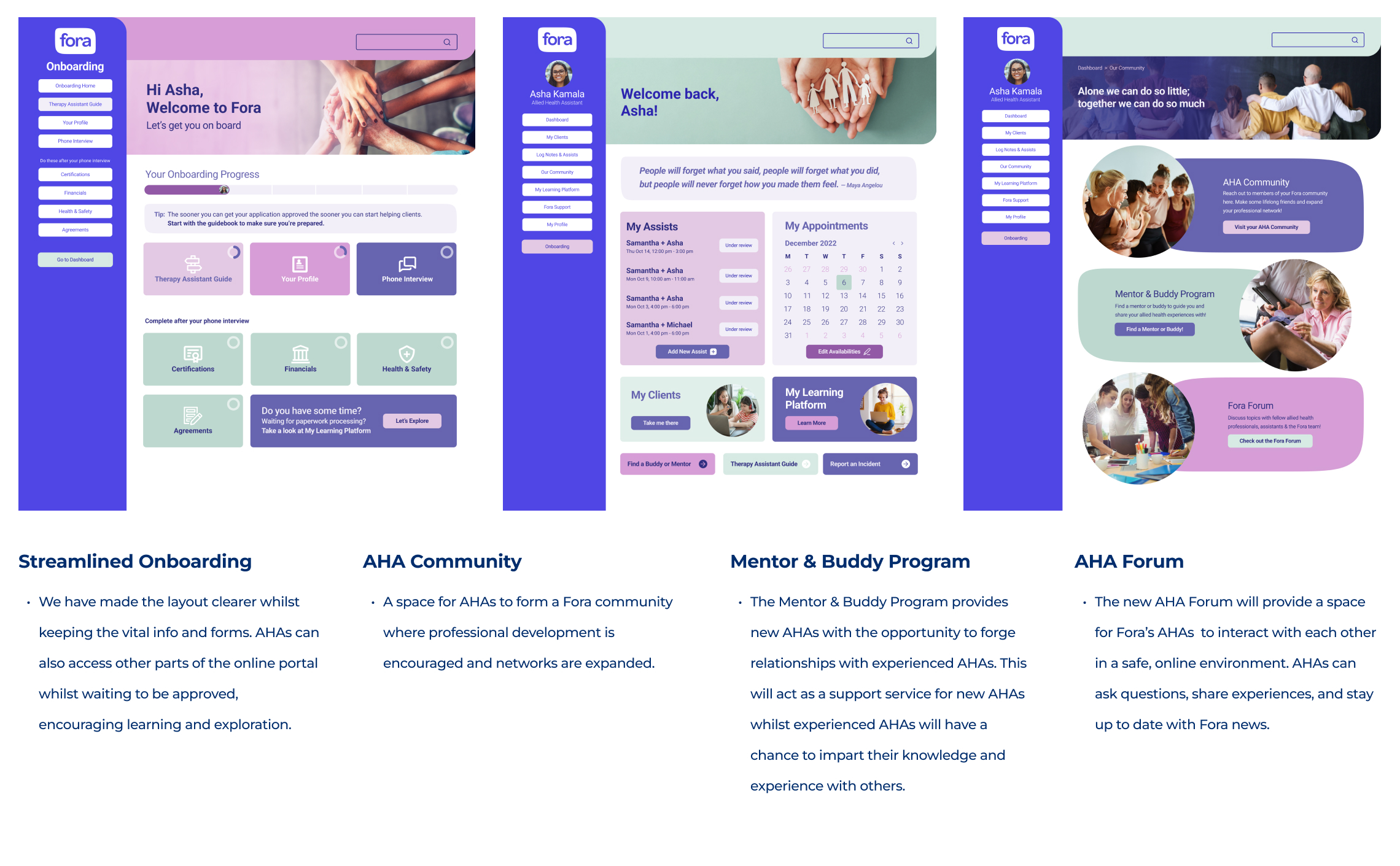
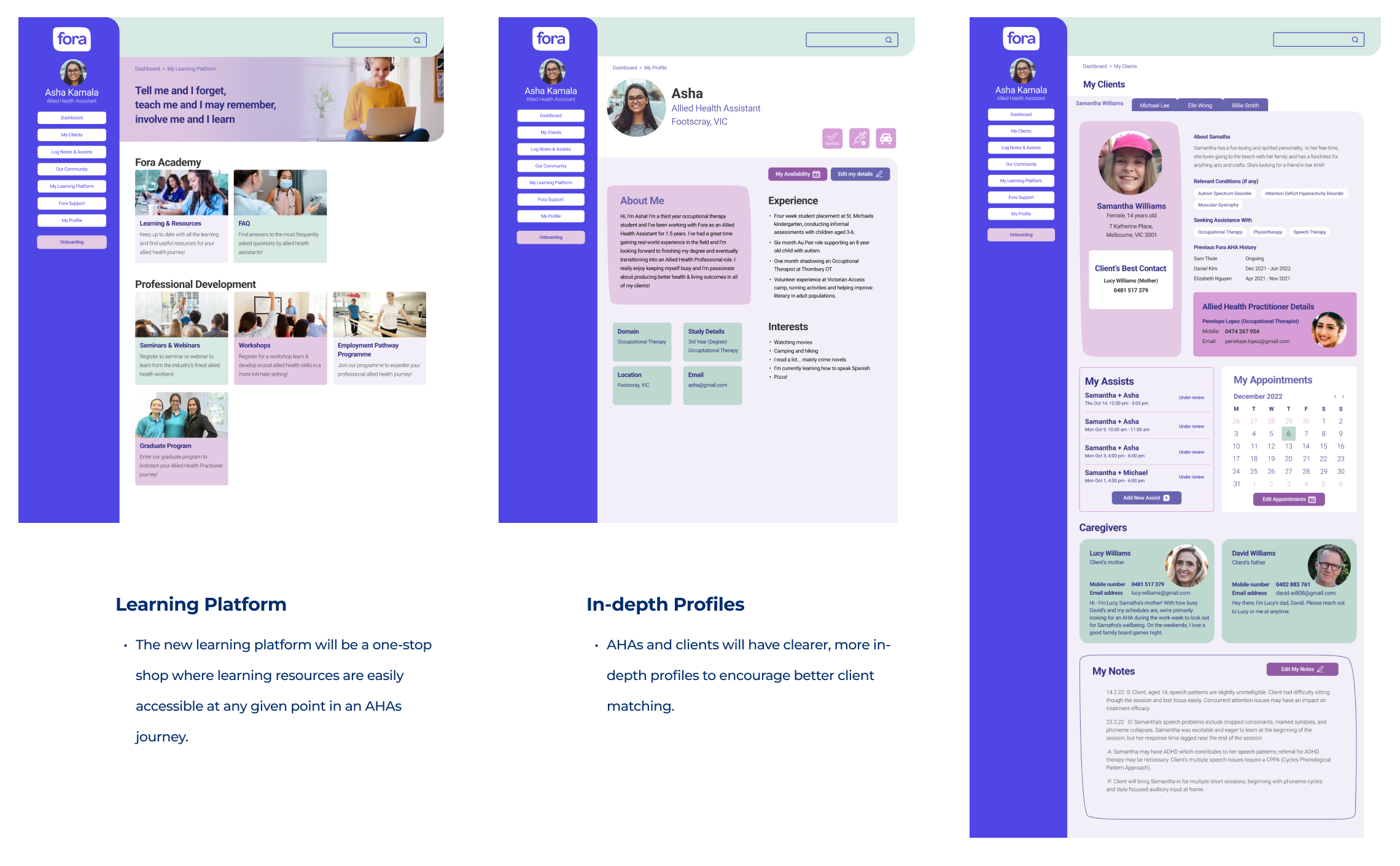
Dive Deeper Into The Journey
That Led To Our Solution
Project Background
A star will be placed beneath the headings where I contributed. My contributions will only be described where necessary.
Overview
This 2.5 week sprint was 1 of 2 client projects I undertook as part of Academy Xi’s UX/UI Design Transform course.
Along with a team of 8 other designers, we were tasked with optimising Fora’s onboarding processes for their Allied Health Assistants (AHAs), as Fora expressed to us that they were experiencing an issue with AHA retention.
Outcome
Whilst we were initially tasked with improving Fora’s onboarding processes for their AHAs, through extensive UX research we discovered that there were other problems contributing to AHAs not staying with Fora. Admittedly, the onboarding process did require some streamlining, but we discovered that the key issue was that AHAs wanted ongoing support and development.
Through undertaking an end-to-end journey and following the double diamond process, we streamlined Fora’s onboarding processes whilst optimising their online web portal and implementing a community support program, a buddy system and learning platform, and enabling better client matching.
The Brief
Key takeaways from Fora’s brief were:
- 50% of matches between AHAs and their clients don’t last more than 1 month
- Fora suggests that this is a result of the current AHA onboarding process
- Fora would like the onboarding process to be more “fun and digestible” for AHAs
- AHAs may be missing key pieces of information and requirements (eg. 6 month commitment) during the onboarding process
- Fora would like us to design a solution that increases AHA confidence post-onboarding
Initial Problem
Statement
“AHAs who are new to Fora feel nervous and are lacking confidence around their new role due to an overwhelming level of critical information. They need an engaging, supportive and easily digestible onboarding experience but face a solo process with hours of reading material.”
User Research
My contributions:
- Desktop Research
- Interview Script Writing
- 1:1 Interviewing
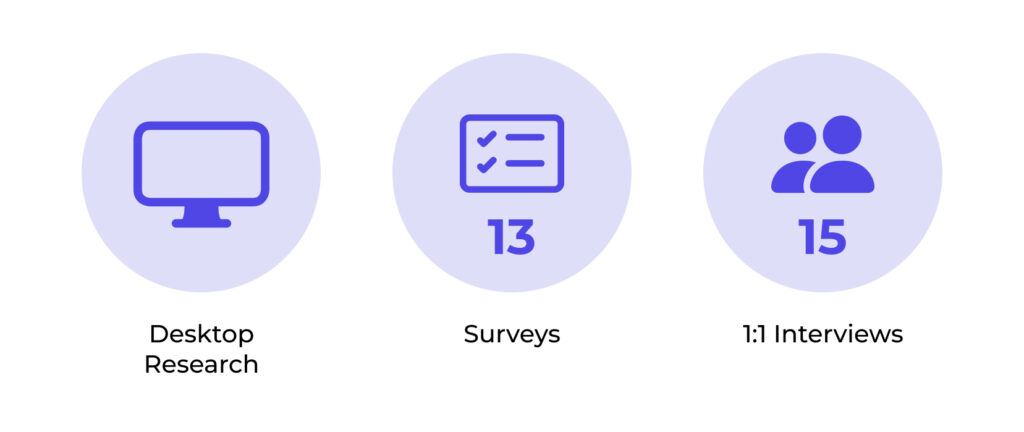
Desktop Research

The purpose of our desktop research was to understand:
- the role and requirements of AHAS
- how AHAs fit into the health ecosystem
- where Fora sits in the market
- how Fora’s client matching services compete with other organisations
Survey Insights

Our initial survey data indicated to us that AHAs didn’t have much of an issue with the onboarding process, contrary to what Fora had suspected. 12/13 of our responders said the onboarding process was informative to very informative, and 83% of them said the onboarding process made them feel prepared and confident for their role.
With this knowledge, we used the 1:1 interviews as a way to probe the AHAs around other potential problem areas.
1:1 Interview Insights

It was at this point that everything started to become more clear. Our interviews revealed that AHAs require more support and community from Fora, the meet and greets with their clients were an issue, and AHAs want more educational and professional support and feedback.
Synthesis

Revised Problem Statement
Our research revealed that rather than the problem being about the onboarding process and information overload, AHAs want more ongoing support from Fora. We revised our problem statement to the following:
“Allied Health Assistants new to Fora feel anxious about working with clients and require more ongoing support and education about their role & the client but face a lengthy and convoluted onboarding process with inadequate follow up.”
Pain Points
- Meet & Greet – The AHAs feel underprepared for their first Meet & Greet as there is little information on the client. The AHAs also feel unsafe having to go into stranger’s home without a support person.
- Education & Professional Development – The AHAs aren’t receiving feedback to know how the are performing in their role. They also aren’t receiving much ongoing support in terms of professional development.
- Employee Experience – The AHAs aren’t feeling connected to the Fora team and aren’t getting a full employee experience due to a lack of engagement with other AHAs.
- Client Matching & Relationships – The AHAs are experiencing long waits to get their first client and then have limited access to information about the client and the family when required.
- Understanding Scope of Work (AHAs) – AHAs feel that their roles are not defined. They feel they are misunderstood by their clients and they are often viewed as a ‘Carer’ rather than as a therapeutic assistant.
Persona
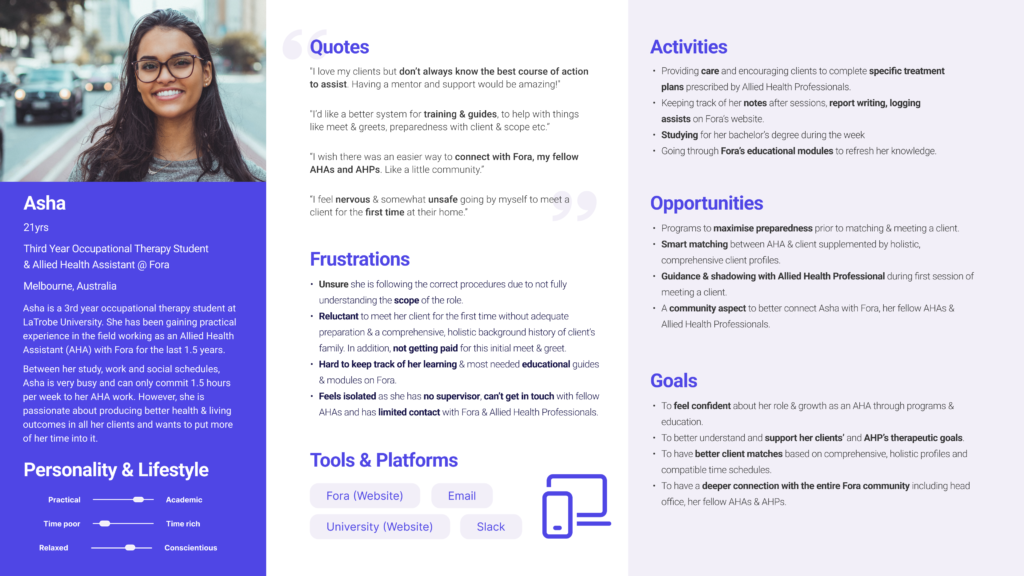
Creating the persona was one of my responsibilities along with one of our other designers, Jimmy. Jimmy and I created Asha based on research insights – Asha’s age, location and life stage reflected our quantitative research data, and everything else was directly taken from our interview findings.
Customer Journey Map

How Might We?
My contributions:
- Brainstorming How Might We Statement ideas
- Voting on the best ones
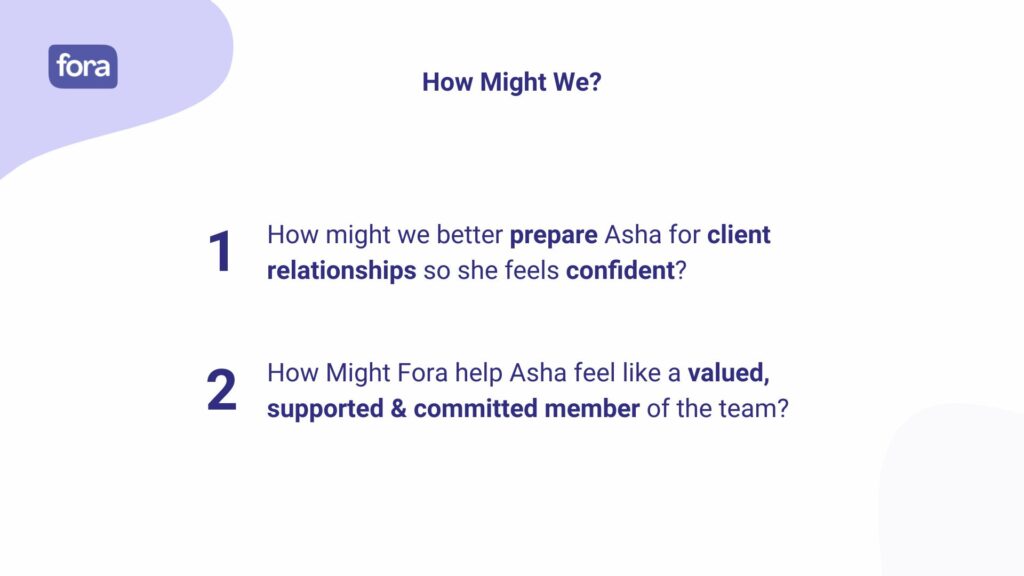
Ideation
My contributions:
- Co-facilitated an ideation workshop with 4 participants.
One of my team members (Sarah) and I co-facilitated an ideation workshop with 4 Ashas to generate ideas to address the two How Might We statements. We took the participants through a Crazy 8 sprint and a group brainstorm session.
This was the 3rd ideation/co-design workshop I had facilitated so I was confident in my delivery. I was comfortable encouraging the participants to think outside of the box, and during the Crazy 8 and brainstorm sessions, I had a good gauge of when the best times were to not interrupt/talk to the participants.


MVP Matrix
Sarah and I then guided the Ashas through a dot scoring voting process to identify the most desirable ideas. We then hosted a meeting with our client CEO Sam, their principal UX/UI designer Bec, and their lead engineer Ale, to go through all of the ideas and to highlight the most feasible and viable ones. These were placed onto a Minimum Viable Product (MVP) Matrix.
Minimum Viable Product (MVP) Matrix

The Solution & Direction
The following ideas were prioritised as the highest impact and quickest wins:
- Online training and professional development
- More detailed profiles for better client matches
- Having access to a supervisor to give me an idea of how I’m doing
- An online handbook
- Being able to interact and speak to other AHA’s
- Feeling safe and confident for Meet & Greet
- Fora T-Shirts/Lanyards to create a sense of belonging in AHAs
The Solution
We decided to optimise Fora’s current online portal which is used by Fora’s AHAs, as well as streamline their onboarding process which is what Fora originally proposed.
User Flows & Sketches
My contributions:
- I was responsible for the “My Profile” flow.
Information Architecture & User Flows
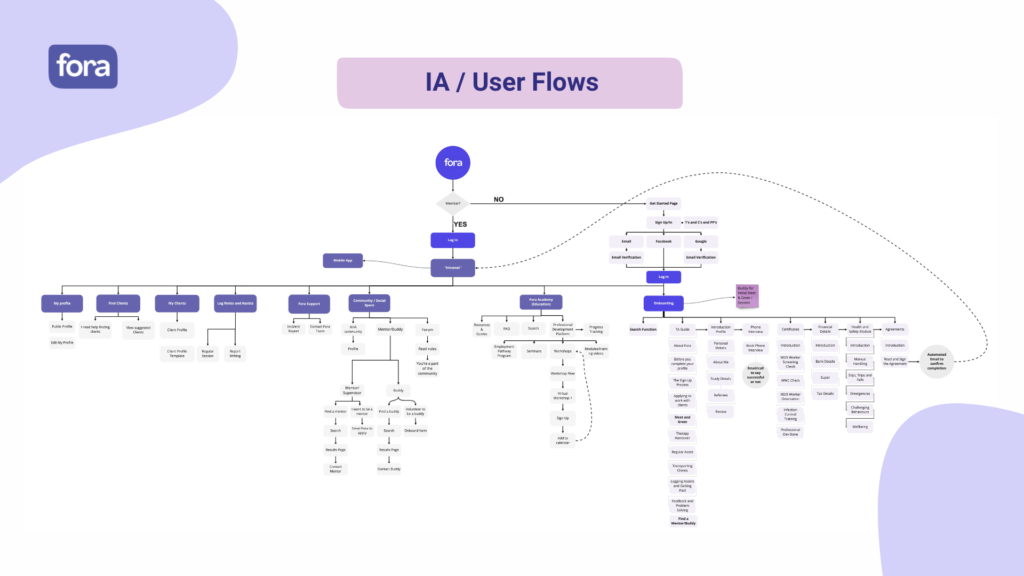
Sketches
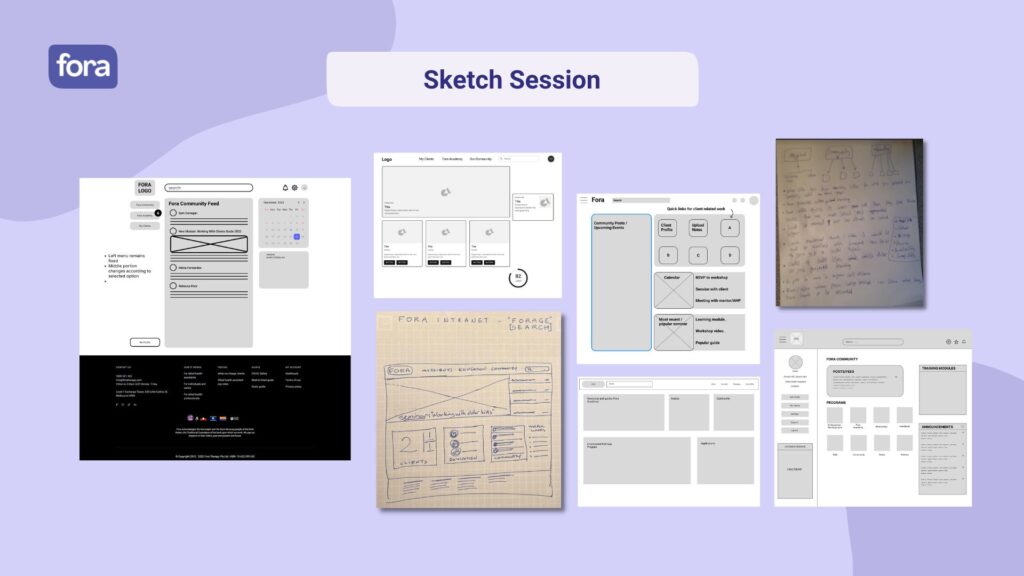
These were some of the rough sketches by members of our team. My sketch was the one in the bottom right hand corner!
Wireframing & Prototyping
My contributions:
- I took ownership of the “My Profile” screens from the user flows and sketches through to the prototyping. However, during the high fidelity stage, I only did basic editing and left the final touches up to the more “graphic design savvy” team members.
I took ownership of the “My Profile” section of Fora’s online portal, so I focused on fleshing out the information architecture and user flows, and I built and iterated on it based on insights from our usability tests.
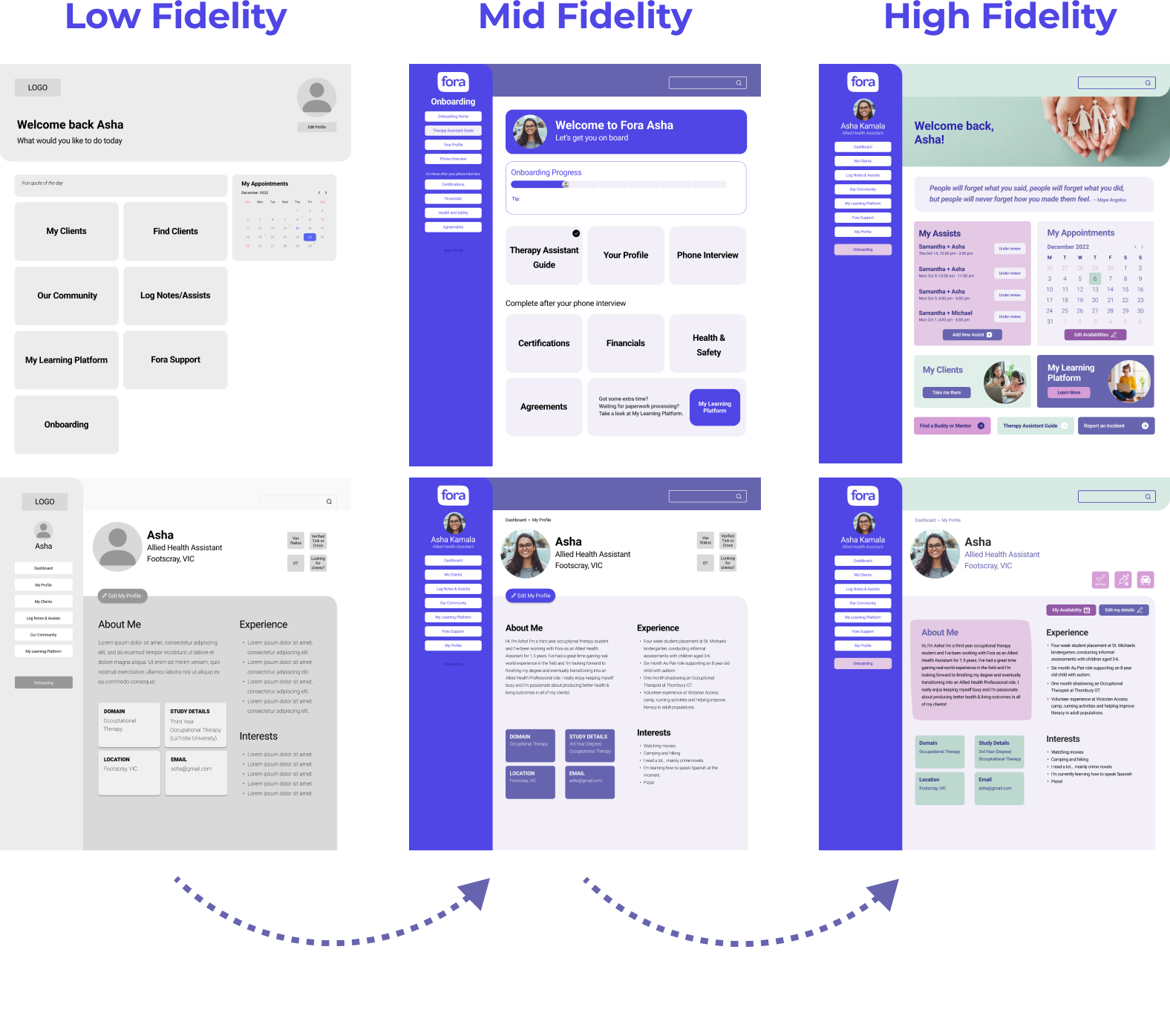
Usability Testing
My contributions:
- Usability Test script writing/structuring.
- I conducted 5 x usability tests on Zoom.
- I synthesised the tests and relayed feedback to the core UI team.
Usability Tests - 13 Tests
One of my primary roles was conducting usability tests. I hosted 5 tests across the low, mid and high fidelity phases, and wrote and strategised the testing scripts and tasks.
Our team conducted 5 usability tests at the low fidelity stage, 4 at the mid fidelity stage, and 4 at the high fidelity stage. We asked the Ashas to perform the following 6 tasks:
- Find the Therapy Assistance Guide.
- From the Onboarding Page, find the Meet & Greet section and checklist on how to prepare for your first Meet & Greet.
- Locate the “Find A Buddy” program.
- Report an incident.
- Update your availability on your profile.
- Find your existing client’s page and their best contact.
Low Fidelity Iterations

Mid Fidelity Iterations
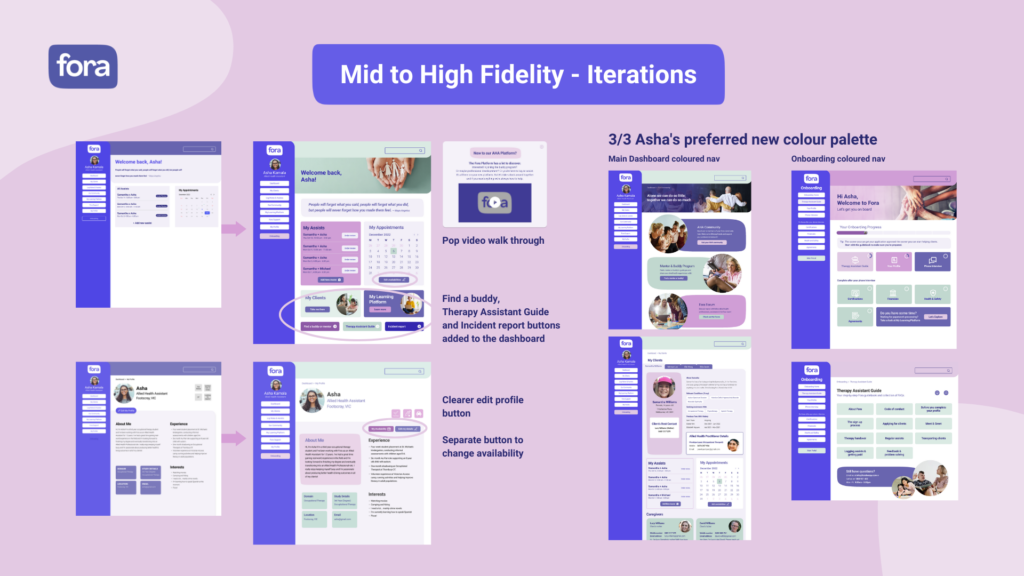
High Fidelity Key Improvement Areas
- 4/4 Ashas didn’t have any issues finding the Therapy Assistance Guide, which was a problem in previous iterations (in Mid Fidelity, 3/4 couldn’t find it).
- 4/4 Ashas found the “update availability” section easily, a huge improvement from the last round of testing where 3/4 Ashas struggled to find it.
Further Testing
2/4 Ashas were still confused when finding the Buddy Program, so this needs to be further iterated and tested.
Expanding the Colour Palette
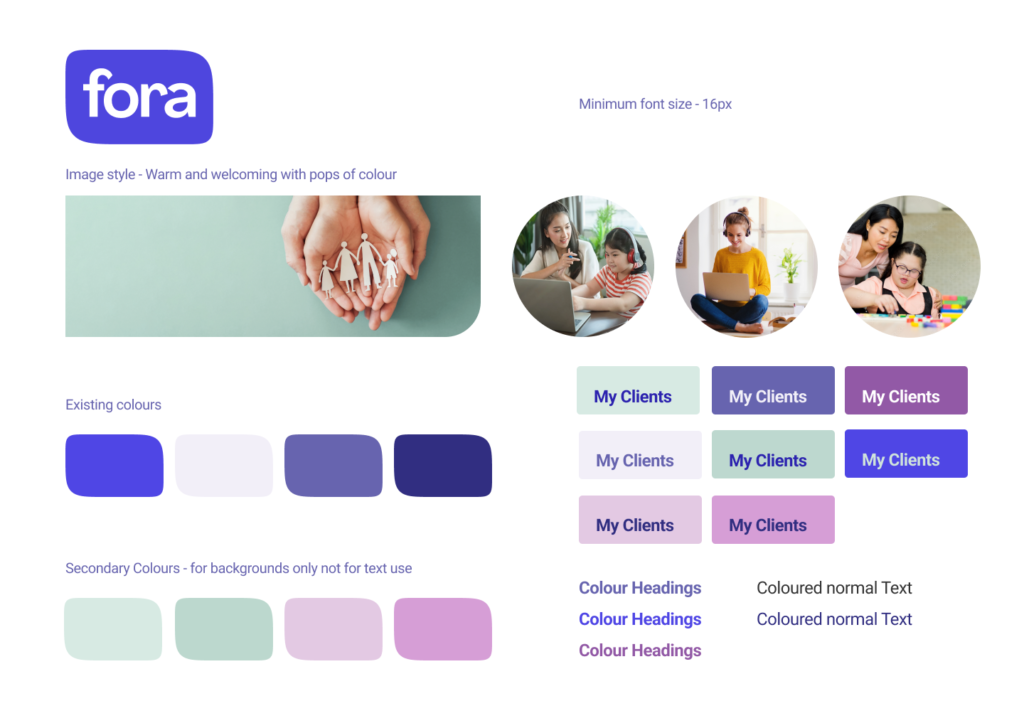
The original palette, which was predominantly a mixture of purple and white, was described by Ashas as “monochrome and stressful” to look at, so we experimented with an expanded palette. The new colour palette, which introduced soft greens and pinks to the mix, was described as “calming and orderly” and “nice and warm”, and still familiar. The new colour palette was received well, with 4/4 Ashas preferring it to the old colours.
As we had validated the new colours in our usability testing, we approached Fora with our proposed colour palette, and our testing insights and metrics. Fora were thrilled. They did, however, ask us to ensure that the new palette adheres to the WCAG 2.1 accessibility guidelines, which we made sure they did.
System Usability Scores (SUS)
My contributions:
- Calculated the System Usability Scores at each level using the formula to the right.
Overal System Usability Scores
Calculating the overall SUS scores was one of my responsibilities. The SUS provides a solid overview of how our design increased in effectiveness, efficiency and satisfaction at each stage.
I used the following formula to calculate our SUS:
- Add up the total score for all odd-numbered questions, then subtract 5 from the total to get (X).
- Add up the total score for all even-numbered questions, then subtract that total from 25 to get (Y).
- Add up the total score of the new values (X+Y) and multiply by 2.5.

Accessibility
Accessibility is always a vital consideration, but for this project in particular, we were extra careful to ensure we followed WCAG 2.1 guidelines as this platform would be used by people living with disability.
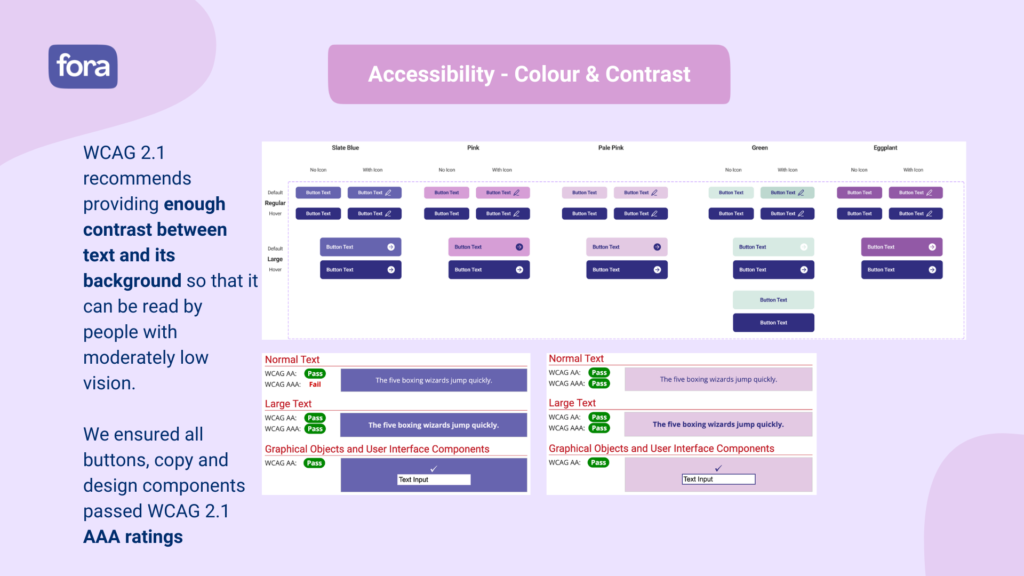
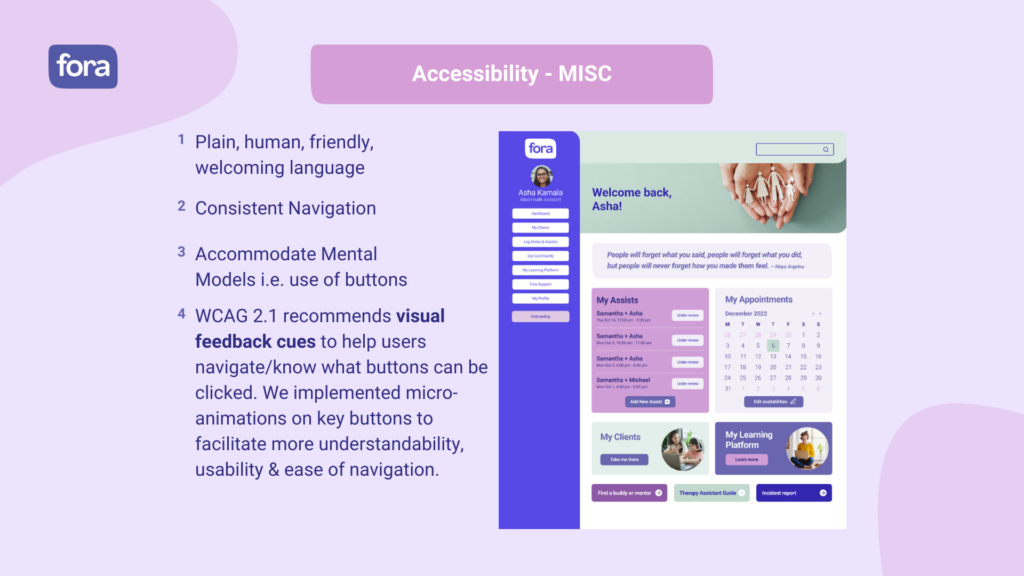
Streamlined Onboarding
We have streamlined the onboarding process by making the layout clearer whilst keeping all of the vital information and forms. AHAs will also be able to access other parts of the online portal whilst waiting to be approved, encouraging learning and exploration.
Fora Community & AHA Forum
The new Fora Community will serve as a space for Fora AHAs to interact in a safe, online environment. There will be a Forum where AHAs will be able to ask questions, share experiences, and stay up to date with Fora news and changes.
Mentor & Buddy Programme
The Mentor & Buddy Programme provides new AHAs with the opportunity to forge a relationship with an experienced AHA. This will act as a support service for new AHAs whilst experienced AHAs will have a chance to impart their knowledge and experience with others.
Learning Platform
The new learning platform will be a one-stop shop where learning resources are easily accessible at any given point in an AHAs journey.
Addressing
the Pain Points
How Are Asha's Pain Points Addressed?
Meet & Greet
Solution:
We proposed moving the initial Meet & Greet to a virtual session in the short term for AHAs who feel more comfortable in this setting. We also introduced a space for a buddy system to allow local AHAs to support one another by asking each other questions and sharing experiences.
Professional Developement
Solution:
Our new learning platform will provide AHAs with access to webinars, workshops, and educational videos for ongoing development and learning.
Community Support
Solution:
We have included an AHA forum where Fora employees can interact online. AHAs can ask questions and share experiences. The buddy program will also act as a support channel for AHAs.
Client Matching
Solution:
We have created a more in-depth client profile system so both clients and AHAs can showcase their interests and needs, thus creating stronger matches and relationships.
AHA Understanding of Role
Solution:
We have streamlined the onboarding steps which will provide more clarity around role responsibilities and requirements. AHAs will also now have access to the new learning platform.
Client Matching
Solution:
We have created a more in-depth client profile system so both clients and AHAs can showcase their interests and needs, thus creating stronger matches and relationships.
Next Steps
To conclude our presentation back to Fora, we presented a short-medium-long term plan outlining how Fora can implement the features we designed. Some of the features we were proposing were not going to be immediately feasible due to budget and time constraints (eg. a mobile app), so, with this in mind, we outlined an actionable plan that Fora can use to implement all of the features we designed, as well as other ideas that we wanted to propose that weren’t necessarily UX-related (eg. Fora merchandise etc).
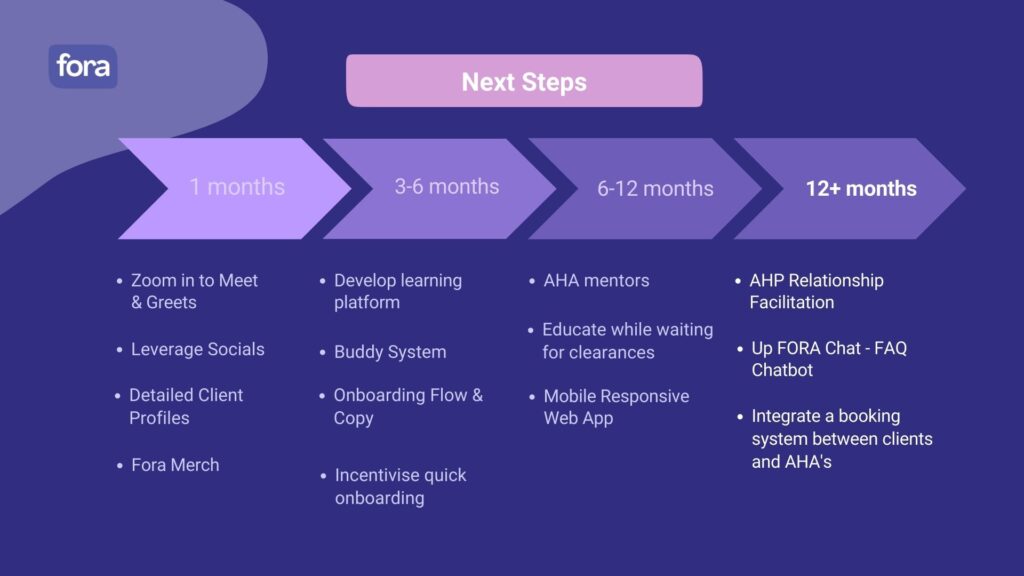
Retrospective

